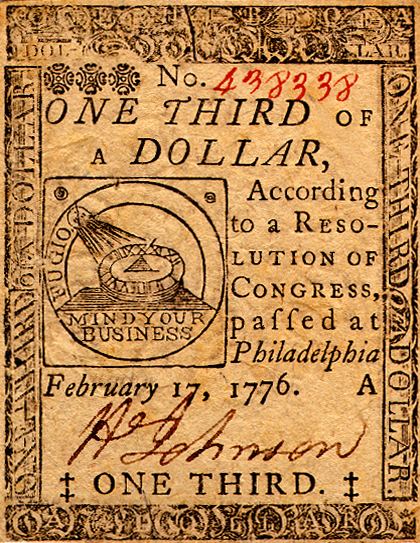 | ||
Multiple types of banknotes of the United States dollar have been issued, including Federal Reserve Notes, Silver Certificates, Gold certificates and United States Notes.
Contents
Continental Currency
Before the American Revolution, every one of the Thirteen Colonies had issued its own paper money, most often denominated in British pounds, shillings and pence. In 1776, the newly created United States issued currency which was bought by people who wanted to support the war (it was promised that the currency could be redeemed for Spanish milled dollars once the war would end). At first, the banknotes circulated at par with the stated value, however after a few months they started depreciating until they became almost worthless. In an agreement, the United States agreed to redeem the notes for treasury bonds at 1% of the face value. The issued denominations ranged from $1/6 to $80.
Fractional Currency
During the American Civil War silver and gold coins were hoarded by the public because of uncertainty about the outcome of the war. People began to use postage stamps instead, encasing them in metal for better protection. The U.S. government decided to substitute paper currency of denominations under a dollar for coins in order to solve the problem. The denominations issued were 3¢, 5¢, 10¢, 15¢, 25¢ and 50¢. There were five issues of fractional currency.
Interest bearing note
Interest bearing notes were issued from 1863-1865 and bore a 5% or 7.3% interest per annum. The 5% notes matured at one year while the 7.3% interest notes (also known as seven-thirties) matured at three years. Their denominations were $10, $20, $50, $100, $500 and $1,000.
Gold Certificates
Gold certificates were issued from 1865 through 1934 and were redeemable in gold coin. Following the 1933 ban on gold ownership in the United States, they were recalled to be redeemed for United States Notes. They were issued in large size through 1929 and in small size thereafter. They were originally issued in denominations of $20, $100, $500, $1,000, $5,000 and $10,000. A $50 note was added in 1882, followed by a $10 note in 1907. A $100,000 note which was used only for inter-bank transactions was also issued in 1934 but never made available to the general public. It is still illegal to own.
Silver Certificates
Silver certificates were issued from 1878 through 1964 and were redeemable in silver coin through 1967 and thereafter in raw silver bullion. Since 1968 they are not redeemable in anything but Federal Reserve Notes. They were removed from circulation in 1964, at the same time as silver coins. They were issued in large size through 1929 and in small size thereafter. They were originally issued in denominations of $10, $20, $50, $100, $500 and $1,000. $1, $2 and $5 notes were added in 1882. Small size notes were only made in denominations of $1, $5 and $10. The small notes were made with a blue seal, except for notes made as an emergency issue for American soldiers in North Africa during World War II, which were made with a yellow seal, as well as a $1 note made for use only in Hawaii during World War II, which had a brown seal.
Refunding Certificate
Refunding Certificates, issued only in 1879 and only in the $10 denomination, were special in that their interest (4% per annum) did accrue indefinitely, which was meant as a way to persuade people into buying them. However, as very few of these notes were redeemed, in 1907 Congress passed an act stopping the accrual of interest, fixing the value of the notes at $21.30.
